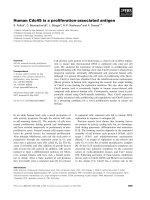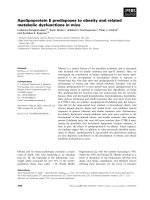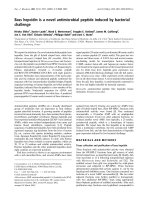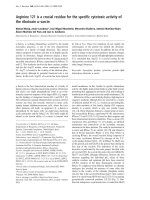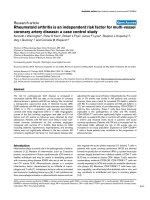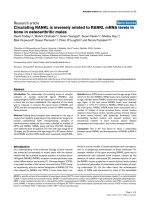Báo cáo y học: "Hand-grip strength is a simple and effective outcome predictor in esophageal cancer following esophagectomy with reconstruction: a prospective study" ppt
Bạn đang xem bản rút gọn của tài liệu. Xem và tải ngay bản đầy đủ của tài liệu tại đây (1.06 MB, 5 trang )
RESEARCH ARTIC LE Open Access
Hand-grip strength is a simple and effective
outcome predictor in esophageal cancer
following esophagectomy with reconstruction: a
prospective study
Chih-Hao Chen
1,2,3*
, Ho-Chang
3
, Yi-Zhen Huang
3
and Tzu-Ti Hung
1,2
Abstract
Background: Surgery for esophageal cancer usually carries considerable complication and mortality rate. Adequate
preoperative evaluation is mandat ory to decrease complication rate. Hand-grip strength is a useful measure to
assess the extent of aging, nutrition and patient’s overall condition. Because preoperative nutrition state and
physiologic aging proces s play important roles in postoperative recovery, we would like to know if hand-grip
strength is an adequate tool for such evaluation.
Material and methods: From January 1st, 2007 to December 31, 2008, there was 68 cases underwent
esophagectomy with reconstruction due to esophageal cancer in our hospital. After excluding 7 patients of
incomplete data and loss of follow-up, there were 61 patients included in the study.
Results: There were 54 men and 7 women. The mean age is 60.7. Most of patients had squamous cell carcinoma.
Patient with weak hand-grip strength prior to operation had exceedin gly high rates of complication and mortality
within 6 months after operation. Compared to other risk factors, low grip strength has highest relative risks for
both mortality and morbidity.
Conclusion: Because test for hand-grip strength is cheap, not time- consuming and has high predictiv e value, it
may be included in routine preoperative evaluation .
Background
Patients with esophageal cancer often present with dys-
phagia and generalized weakness. Resection of the eso-
phageal tumor with concomitant reconstruction, with
either stomach or colon, is the procedure of choice.
However, such procedure still carries considerable com-
plication rates. For advanced disease, life expectance is
often less than 12 months. Hence, adequate preoperative
survey is necessary for all potential surgical candidate s
because complication and mo rtality would definitely
occurred in a certain portion of patients. One of the
important values of preoperative evaluation is to define
those with high risks for morbidity and m ortality. In
addition to routine cancer survey, we often would like
to evaluate patient ’s cardiac function or lung function as
well as laboratory examinations. An ideal evaluation tool
may be cheap, easy to interpret, not time consuming,
not space-occupying, and effective. Hand-grip s trength
is a proper predictor of immune system, nutrition, aging
process, bone density, overall body strength, especially
in old age group [1]. The methods of such test is quite
simple, we therefore want to see if such test has any
role to predict patient’ s outcome after esophagectomy
with reconstruction. The end-points are ICU stay, hospi-
tal stay, complication ra te, days to start oral intake, sur-
gical mortality rate, andmort ality rate within 6 months
after operation.
* Correspondence:
1
Department of Thoracic Surgery, Mackay Memorial Hospital, Taipei City,
Taiwan
Full list of author information is available at the end of the article
Chen et al. Journal of Cardiothoracic Surgery 2011, 6:98
/>© 2011 Chen et al; licensee BioMed Centra l Ltd. This is an Open Access article distributed under the terms of the Creative C ommons
Attribution License ( which permits unrestricted use, distribution, and reproduction in
any medium, provided the original work is properly cited .
Material and methods
From January 1
st
,2007toDecember31
th
, 2008, there were
68 patients included in the study. This is a prospective
study. The study was approved by the institution review
board of Mackay Memorial Hospital. 7 patients were
excluded due to loss of follow-up, could not adequately
perform the tests due to stroke or due to incomplete data,
Patients with other cancer history were also excluded.
There were 61 patients have complete records for analysis.
Patients were tested at leas t 3 times several days prior to
operation. Low hand-grip strength here was defined as
grip strength lower than 25 kg in the dominant hand.
Other laboratory data, history of other co-morbidities and
risk factors were also recorded for risk analysis. The stan-
dard position for testing hand-grip strength is standing
position with upper limb relaxed down to the sides of the
body and palm towards the torso. The elbow is extended
without any flexion. The handedness is also recorded for
comparison. Co-morbidities included diabetes, poor renal
function, hypertension, ischemic heart disease, liver cir-
rhosis or other disease considered to have great influence
on patients’ outcome. Complications included postopera-
tive acute respiratory failure, anastomotic leakage, wound
infection, early esophageal stricture requiring endoscopic
dilatation, and pleural effusion requiring tube drainage.
Surgical mortality was defined as either patients died
within 30 days after operation or in-hospital death without
discharge. Mortality was defined to any pati ents died less
than 6 months after operation during follow-up. Pathology
stage was based on resected specimens. Early stage was
defined as patients having stage 1 and stage 2. Advanced
stage was defined as patient s having stage 3 and 4. All
patients included were followed for at least 6 months in
the outpatient department.
SPSS (version 13.0) was used to help analyze the cor-
relation of each risk factors with morbidit y, mortality
and hospital stay. Chi square test, Student t-test and
Pearson correlation test were used to compare the influ-
ences of each factor. Receiver operating curve analysis
was used to determine the most appropriate cut-off
value of the tests. Regression analysis was used to evalu-
ate the influence of each factor on outcome.
Results
There were 54 men and 7 wo men with mean age of 60.7
years.(range: 34 - 83 years). All patients had undergone
esophagectomy with reconstruction by a gastric tube
through either transhiatal or transthoracic approach.
Transthoracic esophagectomy with reconstruction was
performed in 52 patients and transhiatal esophagectomy
with reconstruction was performed in 9 patient s. Sum-
mary of the surgical approach and other variables is
shownintable1.Onlyfivepatientsunderwent
thoracoscopic esophagectomy with reconstruction in the
group of transthoracic approach. Fifty-seven patients had
squamous cell carcinoma and the remaining 4 patients
had adenocarcinoma. The locations included 6 patients in
the upper third, 31 patients in the middle third and 14 in
the lower third. All underwent surgery for cure intent,
including en-bloc resection of the tumor, esophagus and
radical nodal dissection. 93.4%(57 out of 61 patients) had
right handedness. For risk factors, anemia was found to be
in 3 patients, hypoalbulinemia in 10 patients, chronic renal
insufficiency in 8, diabetes in 11, abnormally elevated
MCV (mean cellular volume of red cells greater than 100
fL) in 22, and presence of weight loss in 29. Twenty-three
patients had at least one major comorbidity. The post-
operative routine included observation in intensive care
unit for one to three days after operation depending on
patient’s condition, removing endotracheal tube one day
after operation, removing nasogastric tube on day 8 and
began oral intake 10 to 12 days after operation when
recovery was uneventful.
Respiratory failure requiring re-intubation was found
in 12 patients, pneumonia in 7 patients, pleural effusion
requiring tube drainage in 5, anastomotic leak in 3 and
other conditions in 4 patients. Surgical mortality was
found in 6 patients. 8 patients died within 6 months
after radical operation. The mean duration to start regu-
lar oral intake is 15.1 days. For patients with tumor in
the upper third of the esophagus, 2 out of 6 patients
had complication but no ne died of disease within 6
months. For tumo r in the middle third, 3 out of 31
patients died and 15 patients had complications. For
tumor in the lower third, 5 patients died within 6
months and 12 had complications.
Figure 1 showed highest rates of complication and
mortality when hand-grip strength was less than 20 kg
and lowest when hand-grip strength greater than 40 kg.
The extent of correlation between hand-grip strength
Table 1 Surgical Approach of patients with operable
esophageal cancer
TTE THE p value
NO 52 9
M/F 48/4 6/3 0.1
Age (year) 60.6 61 0.92
HGS(kg) 29.1 26.5 0.33
HS (day) 25.4 22.2 0.46
ICU stay(day) 7.26 4.7 0.21
Start Oral Intake(day) 15.4 13.1 0.6
6-month mortality 6 2 0.5
Morbidity 22 8 0.06
TTE: transthoracic esophagectomy with reconstruction (including
thoracoscopic and thoracotomy); THE: transhiatal esophagectomy with
reconstruction; NO: patient number; M: male; F: female; HGS: hand-grip
strength; HS: hospital stay; ICU: intensive care unit.
Chen et al. Journal of Cardiothoracic Surgery 2011, 6:98
/>Page 2 of 5
with complication rate and mortality rate reached statis-
tical significance (p value less than 0.001 and 0.020
respectively) The correlation coefficients are -0.546 for
complication rate and -0.369 for mortality rate. The cor-
relation coefficients between age and mortality as well as
morbidity were - 0.052 and 0.122 respectively and not
reached statistical significance. Table 2 showe d the like-
lihood of complication and 6-month mortality rate
decreased along with better hand-grip strength. When
compare to the presence of other risk factors, low hand-
grip strength still carries highest rate of complication,
followed by patients with diabetes.(Figure 2) Abnormally
elevated MCV has borderline significance.(p = 0.059)
Factors thought to be significant to predict surgical
mortality included weak hand-grip strength, chronic
renal insufficiency and presence of at least one co-mor-
bidity. P values are 0.034, 0.038 and 0.036, respectively.
When the duration extended to 6-month, the condition
is somewhat different. Only weak hand-grip strength cor-
related significantly with mortality rate. The p value is
0.016.(Figure 3) Other risk factors have no significance to
predict 6-month mortality. For patients with low hand-
grip strength, the mean duration to start regular oral
intake is significantly longer than those with stronger
hands.(22 days vs 12 days, p = 0.001) The hospital stay is
also significantly longer in patients with weak grip
strength. (32.3 days vs 21.4 days, p = 0.005) In the group
of advanced age (mo re than 65 years old), the hospital
stay was no t longer than young patients. As for the influ -
ence of stage of esophageal cancer, th e average hand-grip
strength was similar in patients having early and
advanced esophageal cancer.(p value is 0.961) Advanced
esophageal cancer itself did not contribute more likeli-
hood of mortality and complication within 6 months
after operation.(p value is 0.229 and 0.177, respectively)
Because the strength of hand-grip declined with age
(Figure 4), we tried to stratify all patient according to
Table 2 The clinical demographics and outcome in patients with weak(< 25 kg) and normal hand-grip strength
Weak HGS Normal HGS p value
N.O. 20 41
Sex(M/F) 17/3 37/4 0.742
HGS(mean, kg) 19.325 33.34 < 0.0001
Age(mean, years) 65.1 58.5 0.01
weight loss 10 19 0.57
stage Early(I, II) 12 23 0.625
Advanced(III, IV) 8 18
ICU stay(day) 12.75 4.05 0.003
Hospital stay(day) 32.3 21.4 0.003
Start oral intake(day) 22.1 12.02 0.001
Complication 17 12 < 0.0001
Mortality 7 2 0.016
HGS: hand-grip strength; M, male; F, female; ICU, intensive care unit;
Figure 2 The odd ratio and relative risk of each risk factors for
complication rate. Both weak hand-grip strength and diabetes
were associated with more likelihood of complication. (p value less
than 0.05) Abnormally elevated MCV has borderline significance.
Figure 1 The rates of complication and mortality in each
group of hand-grip strength. It showed marked increased rates of
complication and mortality when the strength of grip decreased. (p
< 0.0001 and p = 0.003 respectively)
Chen et al. Journal of Cardiothoracic Surgery 2011, 6:98
/>Page 3 of 5
age and then assess if hand-grip strength still contribute
to more likelihood of mortality. Figure 5 showed when
patients younger than 50 years, there was no mortality.
In patients aged 51 to 60 years, the mean hand-grip
strength is 17.75 kg, significantly lower than 29.89 kg in
survived group.(p value: 0.024) In patients aged 61 to 70
years, the mean hand-grip strength is 17 kg, significantly
lower then 30.3 kg in survived patients.(p value: 0.014).
In patients aged more 71 years, the mean hand-grip
strength is 18 kg, only slightly lower then 22.13 kg in
survived group.(p value: 0.33) The facts described that
weak strength is an adequate indicator of poor outcome
in patients aged fr om 51 to 70 years but the predictive
value in patients more then 71 years old is not con-
firmed. The strength of non-dominant hand has no
impact on patients’ outcome in the analysis.
In brief, patients who have weak hand-grip strength
prior to operation tends to stay longer in t he hospital,
need longer time to start oral diet and may have more
risks for occurrence of complication and mortality.
Discussion
Hand-grip strengt h is a useful marker to assess patient’s
physiologic status [2]. It correlates well to patient’s over-
all muscle strength, bone density, nutrition status, and
frailty, even better than chronological age [3]. The rea-
son to test muscle strength to determine the aging pro-
cess is that muscle-specific disease is quite rare. That
means muscle strength declined slowly independent of
other common disease, s uch as heart disease, lung dis-
ease or gastrointestinal disturbance [4]. This indepen-
dence helps this marker as a life-long tool to eva luate
frailty. Although we all know the number of age itself,
that is chronologic age, could not represent patient’s
true physiologic state, we do not use any better and reli-
able measurements to take the place of chronological
age in our routine clinical setting. Hand-grip strength
can be a proper and useful measurement here. Other
evaluations, for example cardiac ultrasound or lung
function test, often require expensive facility and well-
trained personnel. Interpretation of the results is also
complicated and required experience. On the contrary,
performing the test of hand-grip strength costs less than
one minute for both hands and the instructions are sim-
ple. Personnel who perform the test need essentially
minimal training but keep the patient in adequate posi-
tion and then read the number. A simple dynamometer
can be used for at least one to two thousand times
under adequate calibration. It can be a simple, reliable
and cheap measurement.
Figure 3 The odd ratio and relative risks of each risk factor for
mortality rate. Only weak hand-grip strength has significantly
associated with more mortality rates. Other risk factors were not
associated with mortality rate.
Figure 4 The figure showed that hand-grip strength does
declined with age.
Figure 5 The hand-grip strength in mortality and survived
patients was stratified according to age. The mean hand-grip
strength in mortality patients is significantly lower than survived
patients in the range from 51 to 60 years and 61 to 70 years.(p
value was 0.024 and 0.014 respectively) The difference in patients
older than 71 years old was not significant.
Chen et al. Journal of Cardiothoracic Surgery 2011, 6:98
/>Page 4 of 5
The reason we define hand-grip strength less than 25
kg as weak is retrospective. In receiver operating charac-
teristic (ROC) analysis, the cut-off value is 25 kg for
morbidity(Fi gure 6A) and 22 kg for mortality.(Figure
6B) Hand-grip strength less than 25 kg has a sensitivity
of 72.41% and specificity of 84.37% to pre dict morbidity.
Hand-grip strength less than 22 kg has a sensitivity of
75% and specificity of 79.25% to predict mortality.
In the analysis of hand-grip strength in the setting of
esophageal cancer for elective radical esophagectomy with
reconstruction, we found it to be a good predictor for out-
come. We have reasons to suggest test for hand grip
strength as a routine clinical tools for patients requiring
elective esophagectomy with reconstruction. The results of
the hand-grip strength did not indicate any specific phy-
siology defect that other tests fail to detect. In c ontrast,
the results of hand-grip strength can be viewed as a sum-
mary of overall physiological status [5,6].
The strength of hand-grip was also related to bone
density [7]. In patients with femoral neck fracture, hand-
grip strength was found to be a good indicator to predict
the occurrence of both mortality and morbidity [8].
Whether the results can be applicable to other patient
group is not known. However, it is worthy to evaluate its
role in patients planed to undergo an major operation
The limitation of the study is the small number of
patients included in the study and follo w-up duration is
short.
Conclusion
Patients with weak hand grip strength have higher risks
of complication and mortality after elective esophagect-
omy with reconstruction. We recommend the test to be
included in routine preoperative evaluation.
Author details
1
Department of Thoracic Surgery, Mackay Memorial Hospital, Taipei City,
Taiwan.
2
Mackay Medicine, Nursing and Management College, Taipei City,
Taiwan.
3
Graduate Institute of Mechanical and Electrical Engineering and
Graduate Institute of Manufacturing Technology, National Taipei University of
Technology, Taipei City, Taiwan.
Authors’ contributions
CH Chen proposed the idea, designed the study and wrote the whole
article.
H Chang participated in the design of the study and carried out the
statistics.
YZ Huang and TT Hung collected patients’ data and references. All authors
read and approved the final manuscript.
Competing interests
The authors declare that they have no competing interests.
Received: 28 February 2011 Accepted: 15 August 2011
Published: 15 August 2011
References
1. Smith GA, Nelson RC, Sadoff SJ, Sadoff AM: Assessing sincerity of effort in
maximal grip strength tests. Am J Phys Med Rehabil 1989, 68:73-80.
2. Agnew PJ, Maas F: Hand function related to age and sex. Arch Phys Med
Rehabil 1982, 63:269-71.
3. Syddall H, Cooper C, Martin F, Briggs R, Aihie Sayer A: Is grip strength a
useful single marker of frailty? Age Ageing 2003, 32:650-6.
4. Herndon LA, Schmeissner PJ, Dudaronek JM, et al: Stochastic and genetic
factors influence tissue-specific decline in ageing C. elegans. Nature
2002, 419:808-14.
5. Rantanen T, Guralnik JM, Foley D, et al: Midlife hand grip strength as a
predictor of old age disability. JAMA 1999, 281:558-60.
6. Rantanen T, Harris T, Leveille SG, et al: Muscle strength and body mass
index as long-term predictors of mortality in initially healthy men. J
Gerontol A Biol Sci Med Sci 2000, 55:M168-73.
7. Taaffe DR, Cauley JA, Danielson M, et al: Race and sex effects on the
association between muscle strength, soft tissue, and bone mineral
density in healthy elders: the Health, Aging, and Body Composition
Study. J Bone Miner Res 2001, 16:1343-52.
8. Davies CW, Jones DM, Shearer JR: Hand grip–a simple test for morbidity
after fracture of the neck of femur. J R Soc Med 1984, 77:833-6.
doi:10.1186/1749-8090-6-98
Cite this article as: Chen et al.: Hand-grip strength is a simple and
effective outcome predictor in esophageal cancer following
esophagectomy with reconstruction: a prospective study. Journal of
Cardiothoracic Surgery 2011 6:98.
Figure 6 Receiver operating characteristic curve showed the most appropriate cut-off value is 25 kg for morbidity(A) and 22 kg for
mortality(B).
Chen et al. Journal of Cardiothoracic Surgery 2011, 6:98
/>Page 5 of 5
